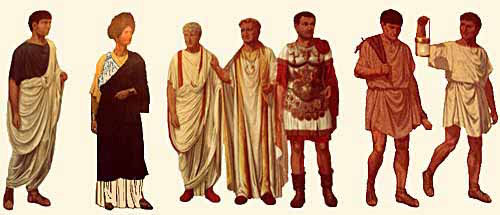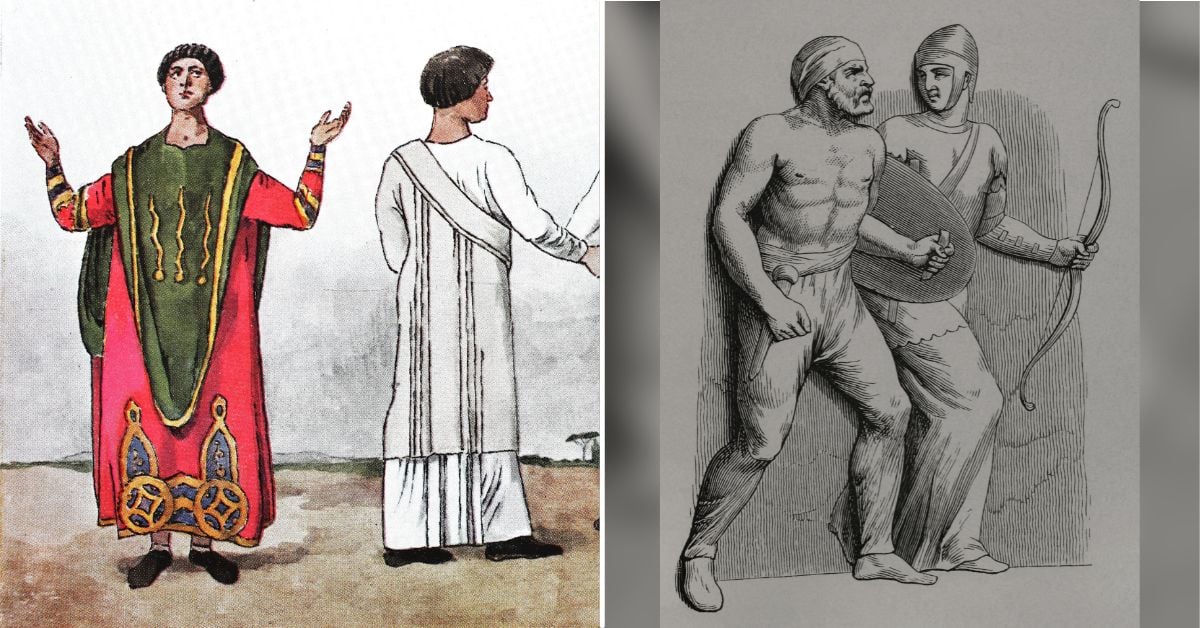In ancient Rome, wearing trousers was not only unfashionable but forbidden by law. This cultural stance made significant statements about social norms and perceptions at the time. Roman attire mainly consisted of tunics and togas, with tunics for daily use and togas reserved for formal occasions. These clothing choices were part of the collective Roman identity, distinguishing them from the so-called barbaric tribes they often confronted. Groups like the Gauls and Germanic tribes, known for their trousers made from animal skins, were seen as uncivilized by Romans.
As time passed, practical concerns influenced fashion. Roman soldiers, facing freezing climates in northern territories, adopted trousers named braccae, better suited for warmth and mobility. Despite legal restrictions that aimed to keep trouser-wearing within military bounds, this style inevitably penetrated broader Roman society. Over time, cultural and practical needs brought about a change in perception. After the decline of Rome, trousers gained acceptance and even popularity, symbolizing a significant transformation in Roman fashion by the sixth century.
Key Takeaways
- Trousers were banned in ancient Rome, linked to cultural identity.
- Roman soldiers adopted trousers for practical reasons in colder climates.
- Over time, trousers became accepted and popular in Roman fashion.
Importance of Trousers in Ancient Rome
In ancient Rome, clothing choices carried deep cultural meanings. Trousers were particularly controversial and even legally restricted at certain times. Instead of pants, Romans traditionally wore tunics and togas. Tunics were for everyday use, whereas togas were reserved for special occasions.
Roman views on trousers largely stemmed from their encounters with different cultures during conquests. For instance, when Julius Caesar invaded Gaul, now France, he found locals in pants, often crafted from animal skins. This sartorial choice was viewed as uncivilized by Romans. Many other tribes across Europe wore similar trousers, leading Romans to associate pants with so-called “barbarian” groups.
Prominent figures like the poet Ovid noted this attire, describing individuals in skins and trousers as seeming foreign and threatening. Pants symbolized a cultural division between refined Romans and the less sophisticated peoples they encountered. Romans used this contrast to emphasize their own cultural superiority.
Despite this disdain, Roman soldiers eventually adopted a version of trousers known as braccae, made from wool and held up by drawstrings. These provided better protection against cold climates faced during military campaigns. As these functional trousers became popular among soldiers, they gradually influenced wider fashion trends in Roman society.
To control this shift, regulations, such as those issued by Emperors Honorius and Arcadius around 400, forbade civilians from wearing trousers, aiming to keep them exclusive to the military. Wearing pants could lead to exile. However, despite the ban, changes in clothing style continued, with trouser-wearing gaining acceptance over time.
By the 6th century, even members of the Roman court in Constantinople wore trousers. This marked a significant transformation in Roman fashion norms, ultimately blending with the customs of previously conquered peoples.
Roman Clothing: Tunics and Togas

In ancient Rome, two main garments stood out: tunics and togas. Tunics were simple and practical, often worn by both men and women. Made from wool or linen, they were rectangular in shape and draped over the shoulders. Tunics were generally short-sleeved for everyday activities and a bit longer for formal occasions.
On the other hand, togas were a symbol of Roman citizenship and were reserved for formal events. Only male citizens were allowed to wear them. Togas were large, semi-circular pieces of cloth that draped elegantly over the shoulder and around the body. The complexity of wearing a toga often reflected the status and wealth of the individual. Different colors and stripes on a toga could indicate a person’s rank or role in society. While tunics were comfortable and practical, togas indicated social standing and were worn with pride.
Trousers were frowned upon and associated with those seen as outsiders or barbarians. Roman leaders sought to maintain a cultural divide between Romans and foreign tribes by discouraging the use of trousers. However, as new climates and military demands shaped the empire, trousers began to sneak into fashion, particularly among soldiers. Over time, attitudes toward them softened, and they became more commonplace.
Conquests and Interactions: The Gauls and Germanic Peoples
When Roman soldiers marched into new territories, they often encountered people with different customs and clothing. Julius Caesar’s conquest of Gaul around 50 B.C. brought Romans face-to-face with the Gauls, who wore pants made from animal skins. This fashion choice puzzled and sometimes disgusted the Romans, who were used to tunics and togas.
As Roman armies advanced, they met various Germanic groups also wearing trousers. Such garments became a symbol of “otherness.” Roman writers and orators often portrayed these tribes as “barbarians,” highlighting their outsider status through their clothing.
Despite initial distaste, Roman soldiers began adopting trousers, called braccae, especially in colder areas. These woolen pants kept them warm in northern climates. Over time, as more soldiers wore them, trousers gained popularity beyond the military.
In a bid to preserve Roman tradition, emperors issued decrees banning the general populace from wearing trousers. This effort was as much about preserving cultural ideals as it was about keeping certain attire linked to the military.
As history unfolded, the Roman Empire eventually fell to these pants-wearing tribes. By the 6th century, Rome’s view on trousers had shifted entirely. The once-taboo attire became a staple, even in the Byzantine court, where close associates of the emperor dressed in long sleeves and trousers.
Publius Cornelius Tacitus and Views on ‘Barbarians’
Publius Cornelius Tacitus, a well-known Roman historian, provided insight into Roman attitudes toward those they dubbed ‘barbarians.’ To the Romans, the term was often used for the various tribes and peoples they encountered and fought against during their empire’s expansion. These groups frequently wore garments like trousers, which were distinct from the Roman norm of tunics and togas.
Tacitus wrote about these ‘barbarians’ and their customs in his works, suggesting that trousers symbolized a cultural divide. Romans often saw these pants-wearing peoples as uncultured or inferior. The clothing choice of these tribes became a symbol of their otherness. Tacitus noted that their attire, including pants, was part of what set them apart in the Roman imagination.
The historian’s writings reflect how Romans tried to reinforce their identity by contrasting it with those they perceived as outsiders. Trousers thus played a role in this cultural perception. The stigma of pants persisted even as Roman soldiers adapted them for practicality in colder climates, making pants slowly more accepted within the military context. Tacitus’s observations help us understand the complex layers of Roman identity and their views on the cultures they encountered.

Roman Soldiers and the Spread of Trousers
In ancient Rome, flowing garments like tunics and togas were the norm. Trousers were largely absent, not just because of fashion, but because they were seen as clothing for outsiders. The Roman Empire spanned a vast area, with many cultures wearing pants. These cultures, like the Gauls and Germanic tribes, were often considered uncivilized by the Romans.
Around 50 B.C., as Roman soldiers, led by Julius Caesar, ventured into places like Gaul, they encountered people wearing trousers made from animal skins. Over time, Roman soldiers began adapting to the climates of the regions they were fighting in. They started wearing braccae, a form of trouser made from wool and secured by a drawstring, which were better for colder climates.
As these trousers became common among Roman soldiers, their popularity spread. However, there was still resistance. Roman emperors Honorius and Arcadius issued decrees to restrict the civilian use of trousers, possibly to maintain their status as military attire.
Despite these efforts, trousers continued to gain acceptance. By the time Rome fell to Germanic tribes, pants had become less taboo. According to some historians, by the 6th century, pants and fitted tunics were common in the Roman court, reflecting a shift in attitudes toward this once-controversial attire.
Laws Against Wearing Trousers
In ancient Rome, wearing trousers was not just uncommon—it was forbidden by law. Roman citizens typically dressed in tunics for daily activities and donned togas for formal events. These clothing choices reflected Roman values and distinguished them from the varied styles seen among the diverse cultures within their vast empire.
The Roman army, especially during campaigns led by Julius Caesar around 50 B.C., encountered several groups in regions like Gaul (modern-day France) and Germany. Many of these communities wore pants, often made of animal skins, a style Romans associated with so-called “barbaric” peoples. The Roman poet Ovid described some of these groups as “odious,” clothed in trousers and skins, which further fueled Roman prejudice.
Roman soldiers, however, began adopting trousers called braccae while campaigning in colder northern regions. These woolen trousers, tied with a drawstring, were practical for the climate and eventually gained popularity beyond the military. Despite this, a decree by Emperors Honorius and Arcadius around 400 A.D. expressly banned the wearing of pants by civilians, reserving them for military use. The penalty for breaching this law could be severe, including exile.
Though the ban aimed to reinforce social order, it reflected deeper cultural biases. Yet, the tides of fashion and necessity are persistent. By the time the Roman Empire collapsed under attacks by the same pants-wearing tribes they’d once derided, trousers had steadily integrated into Roman wardrobe. Over the next few centuries, trousers emerged as standard attire, even within the remaining Roman court in Constantinople.
By the 6th century, fashion in the Roman world had evolved significantly, and trousers had become part of the common dress, illustrating how cultural norms can shift dramatically over time.

Decline of Rome and the Rise of Trousers
In ancient Rome, wearing trousers was not just unusual—it was frowned upon by law and society. Roman fashion was characterized by tunics for everyday wear and togas for formal occasions. These fashion choices reflected the Roman disdain for clothing worn by those they conquered, like the native Gauls, who wore pants made from animal skins. Romans linked trousers with barbarian tribes who were often perceived as uncivilized. Historical sources, like the writings of Ovid, highlight how these tribes’ attire, including trousers, signified their otherness and uncouthness.
Roman soldiers, faced with colder climates, eventually adopted trousers known as braccae, crafted from wool and fastened with drawstrings. Although practical, trousers remained largely unpopular among Roman civilians. Even so, pants gained popularity, pushing emperors like Honorius and Arcadius to ban the civilian use of trousers with the intent to reserve them for military use. Violations of this decree could lead to exile, which reflects the intense social and legal pressures against pants.
The fall of Rome was marked by invasions from Germanic tribes, such as the Visigoths, who were known for their trousered attire. Ironically, after these tribes toppled Rome, trousers became more acceptable. In the only remaining Roman court in Constantinople, trousers even became a sign of proximity to power. By the 6th century, fitted tunics with pants were common in the imperial court. Thus, what was once a symbol of uncouthness became a fixture in the wardrobes of those in close imperial circles, illustrating a significant cultural transformation over the centuries.
Changes in Roman Clothing in the 6th Century
During the 6th century, there was a noticeable shift in Roman clothing styles, especially among those close to the emperor. Traditional Roman attire, such as the tunic and toga, began to incorporate elements once seen as foreign. Notably, trousers became more common, signaling a cultural shift following the fall of Rome to Germanic tribes.
Fashion Elements of the Period:
- Trousers: Once viewed as attire for “barbarians,” these became standard wear in the emperor’s court. They were practical for colder climates.
- Fitted Tunics: These garments featured long sleeves and were popular among higher ranks, often signifying proximity to the emperor.
- Influence of Conquered Cultures: The adoption of so-called barbarian styles highlighted the blending of Roman and Germanic traditions.
With these changes, Roman fashion evolved from exclusive toga wearing to a more diverse wardrobe that included previously shunned items like pants. This transformation reflects the broader cultural exchanges of the time.
